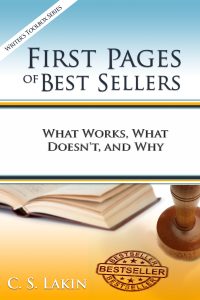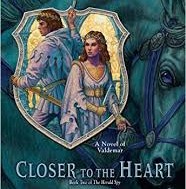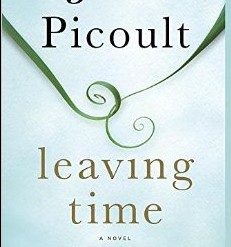Considerations for the First Page of Your Novel
I hope you know why it’s so important to craft a terrific first page. Surely if your first page is awful, it’s likely your reader won’t read further. And that’s a bad thing.
When we realize that literary agents often won’t read beyond the first paragraph if it doesn’t spark interest, it puts a lot of pressure on us writers to come up with a stellar first page.
But it doesn’t and can’t stop there. A great first page is not going to make up for the next three hundred blah pages.
While there is a ton to learn about scene and novel structure (and my blog contains something like a million words of instruction on those topics, so dig in!), there are some key lessons to learn about fiction writing from focusing on the first page.
Why? Because the elements on a first page should (and usually do) reflect the quality of writing in the rest of a novel. In other words, you can’t just work hard to make that first page sing and then ignore the rest of your manuscript.
These first-page elements are ones you can look for on every page of your manuscript. A microcosm reflecting the macrocosm.
 This is why I put together all those first-page analyses I did some years back on Live Write Thrive. So many readers commented to me how helpful they were, so that got me inspired to curate them all and add in more content to help writers learn some very important skills via these first pages.
This is why I put together all those first-page analyses I did some years back on Live Write Thrive. So many readers commented to me how helpful they were, so that got me inspired to curate them all and add in more content to help writers learn some very important skills via these first pages.
Here are some passages I’ve pulled out that my new book First Pages of Best Sellers: What Works, What Doesn’t, and Why.
Everything Filtered through the POV Character
When we describe something in a scene, it comes through the POV character’s filter. Your character should notice things he would notice and form immediate impressions based on what he sees as well as who he is in the era in which he lives.
You are in your character’s head, and so to create masterful description, the first obvious requirement is that you truly know your character. And this is the key to all brilliant writing in a novel.
If you don’t craft deep, complex, unique characters that are wholly real to you, you aren’t going to write terrific description. Before you can describe a character through Jim’s eyes, you have to really know Jim. You have to know the way he looks at the world, at other people, at himself. Jim has to have a unique voice, and that voice comes through every word in a scene, even the narrative. You need to know Jim’s issues and fears and upbringing and background and prejudices and attitudes … and the list goes on.
It’s evident when writers haven’t taken the time to create real, unique characters. Undeveloped characters aren’t going to see the people and world around them in brilliant ways. This will be apparent in your first page, when you attempt that strong open in your character’s POV and voice.
That’s the first step, perhaps one you haven’t considered, to crafting amazing description.
When you read great description, think about what the passages tell you about not only the character or setting being described (through that POV filter) but also about the POV character’s attitude, observations, and personality. The trick to great description is to know what details your character would notice and why, and then what he’d be thinking about what he sees.
It’s worth taking the time to read and study great writers. This is how you will be inspired and learn to be masterful in your craft. If you read garbage, you’ll write write garbage.
When you’re thinking up character descriptions, don’t limit yourself to just the physical and visible. Those are often the least revealing (about both the character describing and the one being described).
To Prologue or Not to Prologue
Many of my editing clients ask me whether their book should begin with a prologue. Some have heard that prologues “are bad.” Or “agents hate them.” Or “prologues are for amateurs.” Granted, a prologue written for the wrong reasons reveals amateur writing. But a prologue that is skillfully crafted can not only set up the novel’s premise effectively, it can also be a terrific way to grab a reader by creating mystery and tension quickly.
There are no rules about prologue length, but they are often short. With fantasy, though, you might find a lengthy prologue showing an important scene playing out centuries before the novel’s present story starts.
More often than not, though, a prologue isn’t necessary, and the information presented in it could just as easily (and maybe in a better way) be revealed through the main story’s characters’ dialogue and thoughts.
Frame Structure Using Prologues
But the issue usually isn’t whether the prologue is necessary or not. More likely it’s about style and setup. A prologue can dramatically set the stage for your story in a wonderful way. There are many types of prologues. One I particularly like, for effect, is a frame structure that starts a novel off with a key scene that comes later in the book. I’ve used this a number of times in my own novels, and I love when it’s done in movies.
The scene chosen is usually part of the climax or close to it. It might show the moments right before a murderer is identified or the key event in the novel occurs. It could be a part of a scene in which the protagonist has to make the hardest decision of her life. Whatever the genre, usually this kind of prologue hints at what is to come, enticing the reader into the story. It’s akin to a good movie trailer (“good,” meaning it doesn’t give away the whole plot, as some awful movie trailers do).
In my new book, we take a look at the opening of the blockbuster novel The Girl on the Train. With just one brief, powerful paragraph, the author gives a peek of the murder that this story is wrapped around. We never witness the murder; it happens off stage. But this chilling first-person paragraph of the character at the moment she is dying frames the entire novel to follow.
Prologues can be useful if you need to impart key information that cannot be revealed in your novel’s present story. For instance, you might need to show something that happened years earlier that sets the stage for your story that the characters never learn about and can’t ever know. That isn’t a common situation, though, and what we often see in novels by beginning writers is a huge info dump in a prologue telling what happened before the “real” story starts. This is information the author thinks the reader must know before she begins reading. But the truth is the reader doesn’t need to know any of it.
If you’re not sure whether your book needs or could use a prologue, it might help to thumb through a bunch of best sellers in your genre and find and read some prologues. See how long they are, what info they convey, and if you feel they’re effective in drawing you in and making you want to read further. And, most importantly, see what they don’t tell you, how they leave you wondering.
Opening Pages of Series
While it can be presumed that most readers of a series have read some or all of the previous novels and know the characters, writers should keep in mind that some readers won’t have. Which means those opening pages should be easy for anyone to understand and follow.
On occasion, I’ve started to read a novel that was part of a series (not the first book) and found it too hard to make sense of. Frustrated, and unwilling to put out the effort to stick with the story (in hopes everything would soon be made clear) or go find the first book and read that before resuming, I gave up.
It’s a fine art to learn how to immerse both new and faithful readers of a series in the opening pages of a new installment. These pages shouldn’t be filled with backstory and explanation meant to fill in the blanks for new readers. Yet, they need to bring out enough elements from the previous books about the characters and premise necessary for the present story. But this should be done in a way that won’t annoy fans who already “know all this stuff.”
Some novels have hardly any reference to previous plots, as in the case of Elizabeth George’s terrific mystery novels. Characters will grow and change over the series (as we also see in TV series), but only on rare occasion is a previous incident mentioned or thought of, and only where and when it serves the present plot—which is as it should be.
These are just a few concerns discussed in my new book. Analyzing best-seller first pages will give you insights about fiction you may not have considered.
You can learn important skills from analyzing best-seller first pages. It’s not just about the first page!
When you learn how to spot weak writing, fiction flaws (such as POV violations), and blah character development, you will be able to spot it in your own writing. As with the 12 Fatal Flaws of Fiction Writing book, this new installment in The Writer’s Toolbox series is a must-have reference to help you become the best fiction writer you can be!












Your new book is great. It could not have come at a more opportune time for me since I have filled several trash cans with attempts at my ‘first page.’ I received your book Friday and finished reading it Saturday. Now I’ll re-visit it again and again as I continue working on that all-important ‘first page.’
So glad to hear it, John! Have fun going through the checklist!
C.S. –
Your spin on prologues in this post is so enlightening. Particularly given that I am bound and determined to include a prologue in the novel I am currently developing. It has three threads that tie back into the story – two of them much earlier in the book, the other one at the end.
Daring? You bet.
Thanks for sharing all your wonderful insight and experience, C.S. It gives us “rookies” hope.
P.S. I just bought the book on Amazon.
Thanks! Glad to hear this was helpful to you. I have a number of prologues in my novels, and I actually like using them in creative ways! To me they are compelling ways to set the stage for the story to come.
I purchased the book. It sounds very helpful and I need all the help I can get. Two things, though. 1) I somewhat disagree with your statement that a novel starts with a key scene that comes later in the book. I find it jarring to read something exciting only to find myself back in time and in a more mundane existence. Though I tolerate this practice, it’s not my favorite way to start a book or a movie. 2) I am considering what you said about giving your readers a preview of the other book(s) earlier in the series. You said not to fill the pages with backstory, but instead write the backstory slowly into the scenes. This makes sense because this is how backstory should be done anyway. But what are your thoughts on doing a short synopsis at the beginning? Perhaps call it a Synopsis of Book One or something rather than Chapter One so that readers know they can skip if if they wish.
I’m wondering now whether I need to edit my first page (probably!) Great advice, thank you.